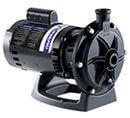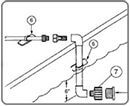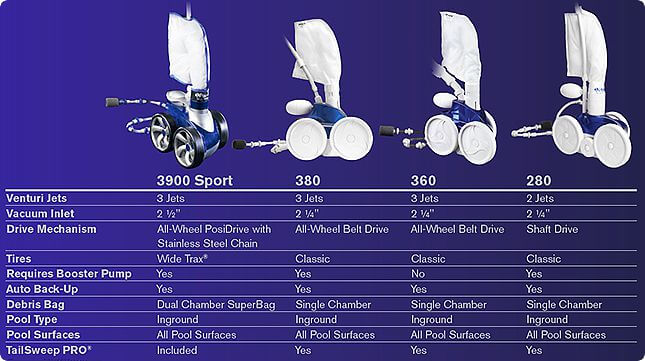FREE Standard Shipping On All Orders $100 or More!*
How to Install a Polaris Pool Cleaner

Installing a pressure-side pool cleaner like the Polaris 380 or the Polaris 3900, is a great ay to automatically clean your pool, giving you more pool fun and less pool work. Polaris pool cleaners are industry leading pressure-side cleaners, compatible with all types of in-ground pools. It scrubs and sweeps and climbs walls. It runs on it's own timeclock, making it fully automatic.
Bottom line, a Polaris pool cleaner will seek out that bothersome debris and get rid of it for you. Below are a few things to know as you are getting ready to install your new pressure-side pool cleaner.

All pools have suction lines that draw water from the pool to the filter, as well as pressure lines where it is pushing water back to the pool. When using a pressure-side automatic pool cleaner a dedicated cleaner line [pipe] sends water to the cleaner, powered by a second pump called a booster pump. Polaris makes two booster pumps, the newly redesigned PB4 booster pump (shown), and the Polaris Halcyon pump, which is quieter and easier to service.

DEDICATED CLEANER LINE: In our schematic you can see the water is pulled into the skimmer and main drain, travels to the pump and filter and then returns to the pool. At the tail end of this journey a tee fitting provides water to the booster pump which in turn blasts it out to a separate return line, shown in orange. This line is plumbed solely for the cleaner, which is why it's called a 'dedicated cleaner line'.
A dedicated cleaner line can be used for both pressure-side or suction-side automatic pool cleaners and can be switched from one type to another with some new plumbing. On a new installation of a dedicated pool cleaner line it is recommended to place it mid-pool for ease of use.
BOOSTER PUMP INSTALLATION: The installation of a pressure-side automatic cleaner, such as the Polaris 380, on an existing pool will require you to plan for the booster pump. do not bury the booster pump within a tangled network of piping, so that it's hard to reach. Give it a serviceable space, close to the return pipe, and also close to the power supply. Take a few minutes to draw out a plan before starting the booster pump installation.
The tee fitting that will feed water to your booster pump should be at least a few feet away from any heaters, but before any chlorinators or salt systems. Find a spot on the return pipe where you can cut the pipe and insert a tee fitting, that is pointing down, toward the booster pump. Reduce the tee fitting to 3/4", by using a reducer bushing, or just find a reducing tee (shown). Make sure it's a deep socket pressure fitting, not a drain fitting. You'll also need another slip x thread reducer fitting on the end of your cleaner line.
Next, you can connect the included Polaris booster pump hose kit. Wrap the threads 3x in Teflon tape and thread two of them into the booster pump, one into the tee fitting, as shown, and one into a threaded reducer that is glued into a 45 or 90 fitting, at the start of your cleaner line pipe. Now you can measure and cut two hose sections to fit from the tee into the pump, and from the pump into the cleaner line. TIP: Cut the hoses longer than needed, to allow for a smooth arc of the hose.
Booster pumps should be wired by a licensed electrician, conforming to all relevant building codes. it is factory wired for 220V but can be installed 110V by attaching a grounded extension cord. You can manually switch the booster pump on and off, but I'd recommend using a dedicated time clock to do it for you - it is about ease of use not more pool work! The main filter pump should always be operating when the booster pump is on, and Polaris pressure cleaners only need 1-3 hours to clean the pool, so set your timeclock for the minimum time needed to keep your pool clean, during the time your main filter pump is running.
PLUMBING THE CLEANER LINE: If your pool never had a dedicated cleaner line, you have the option of using aboveground pipe or HD hose, and/or installing underground pipe when adding a cleaner line after the pool has been built. For the last few feet, you can either tunnel under the pool deck and drill through the pool wall to install a wall fitting and connect the pipe, or use an Over-the-Deck installation kit with HD hose running across the pool deck.

Keep in mind that while it is OK to run a smaller diameter pipe for your cleaner line, the standard 1.5" Schedule 40 PVC pipe is what Polaris recommends. Dig a trench for the new pipe, from the equipment pad to the edge of the pool deck, in the middle of the pool. Lay in and connect your pipes, using 90 degree elbows at both ends, to stub up a pipe out of the ground, next to the pool deck, and on the other end, next to the booster pump. Then connect the booster pump discharge hose to the start, and a length of HD hose to cross the deck, to the connection point for the pool cleaner.
INSTALLING THE POOL CLEANER: The first step is to measure the depth of your pool and cut the leader hose (labeled by manufacturer) to the depth of the deepest part of your pool. Afterward, attach the leader hose to the pool cleaner and the other end to the wall fitting or Over-the-Deck connection. Now pull the cleaner to the furthest point of the pool. On smaller pools, excess hose should be taken equally from the two feed hose sections. On very large pools, you can buy and install another feed hose section, hose floats and hose swivel, if needed.
it is recommended that you check the wheel RPMs at this point to check for proper functionality (28 to 32 RPMs). Mark one of the wheels with a pen or tape and place the cleaner under water. Turn on the booster pump and count the revolutions of the wheel, as you track time. After 30 seconds, you should have 14-16 wheel revolutions. If there is too much pressure, the cleaner can be too active, and practically climb out of the pool. Excess pressure can be bled off at the wall fitting.
TESTING, TESTING... Check out how well the cleaner does! Remember to run the filter pump when running the booster pump. It should clean your entire pool in 1-3 hours, depending on how big and how much debris is in the pool. Polaris cleaners are designed with a back-up valve, and after 3 minutes of random cleaning, the Polaris will stop moving and the back-up valve will spray out water, pulling the hose (and cleaner) off the floor for about 30 seconds. Basically, this is in case it gets stuck on steps or ladders, it redirects the cleaner. You can adjust the sweeper tail if it seems too active; it should slowly sweep back and forth.

I hope I've explained the topic of how to install a Polaris pool cleaner in enough detail, so that you can see how easy it is to install on your own inground pool. Using a pressure-side automatic pool cleaner such as the Polaris 380 or the Polaris 3900, is a great way to clean inground pools, freeing up your valuable time for other activities. it is a relatively simple machine that will amaze you with the amount of power it produces.
Pressure side cleaners are my favorite type of pool cleaners, and if you have a problem with large debris in your pool ~ this is the cleaner for you!